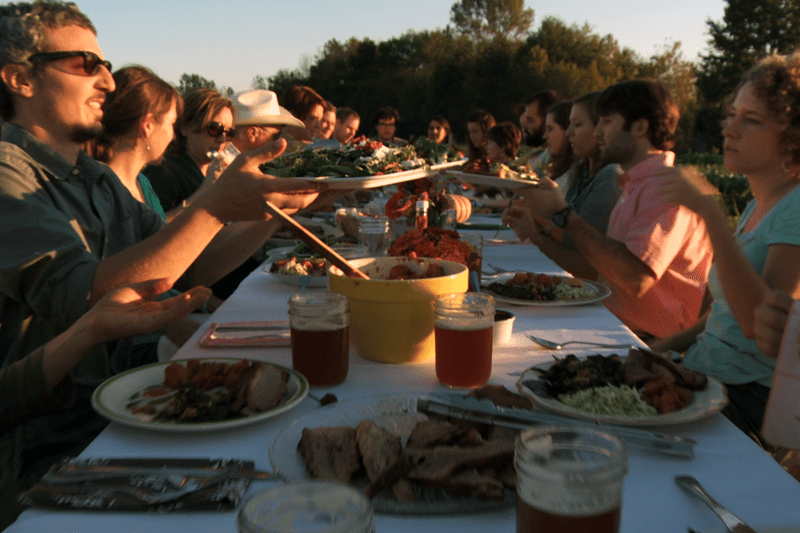
A still from the documentary Eating Alabama.
People in Alabama love to gather and, when they do, it’s usually around football or religion and it is always fortified with plenty of food and drink. What would happen, the organizers of a recent event called the Alabama All-Star Food Festival wondered, if you gathered people just for the eating and drinking — and elevated the discussion of local food in the region while you were at it?
Yes, there was pulled pork and white bread drowning in sauce, but the convention center where the recent All-Star Food Festival was held on account of rain was also full of Gulf shrimp and grits, local gumbo, crab cakes, and of course cold cans from Good People and Back Forty, two of the state’s three microbreweries. The building filled up with farmers, chefs, and food pioneers celebrating a new wave of Alabama food, and wafting over the sterile convention center air was the smell of a place regaining its culinary roots.
As agriculturally rich as Alabama is — both in soil and tradition — the state produces less than 5 percent of the food consumed there. In recent decades Alabama has moved far away from its small-scale farming roots toward concentrated animal feeding operations (CAFOs), raising large numbers of chickens and hogs, and families indentured to corporate agriculture. In fact, just this year, Gov. Robert Bentley (R) cut state funding to Alabama’s Farmers Market Authority, which runs 30 markets throughout the state (another 45 are outside of state control).
Edible revival

Panelists at a discussion of the local food economy at the recent Alabama All-Star Food Festival.
Just 10 years ago it would have been impossible to draw 500 participants and over 30 food vendors and producers to an event focused on local, sustainable food. And the Alabama Sustainable Agriculture Network (ASAN) has a lot to do with the grassroots movement behind the change. For a decade the nonprofit has been gathering small-scale farmers and ranchers throughout the state in an effort to organize, educate, and network producers and consumers.
“Most of us are contrary farmers. We like to work independently,” says Tom Simpson, executive director of ASAN. “So asking them to participate in an association is difficult. We recognize that and we don’t want to be making edicts to farmers out of Montgomery.”
ASAN has created a food guide (soon to be available online) to connect people to healthy food in the Huntsville, Birmingham, and Mobile areas. They’ve also recently turned their efforts toward policy in the state capital of Montgomery.
“We’re trying to pass a bill that offers restaurants a 4 percent sales tax rebate when they buy food locally,” says Simpson. “We’d like Alabama to follow North Carolina and incentivize state institutions to buy 10 percent of their produce from state farmers.”
Measures like that could keep millions of dollars in the local economy, rather than sending them to food distributors elsewhere. The bill, however, could hit a big, red wall in the state capital.
The energy and excitement in Alabama, for now, lives on the ground level. There are over 1,000 farmers in the ASAN network, and another new organization, Front Porch Revival (FPR), launched recently with the goal of identifying, celebrating, and promoting local artisans throughout the state.
Rob McDaniel, executive chef at Spring House Restaurant and a founding member of FPR, says he hopes to connect producers to restaurants with questions like: “I need [local] eggs, where can I get them?”
“Quality and commitment to sourcing locally are the key factors to this alliance,” McDaniel added, while speaking on a panel at the All-Star Food Festival. “We want beer makers, cheese makers, dairy farmers, beef producers. We’d love to have an artisan and urban farmer in every county.”
The panel made for an illuminating cross-section of the state’s new food revolutionaries. Opposite McDaniel sat Andy Grace, a young documentary filmmaker who grew up in Alabama and recently settled back in his home state, where he is now a film professor at the University of Alabama and the director of the new documentary, Eating Alabama. Grace recognized that in the largely rural, deeply conservative state, the “notion that local food is an elitist, urban luxury is an obstacle.”
Next to Grace sat Frank Randle, a barrel-chested, deep-voiced rancher reminiscent of John Wayne. He and his sons raise cows on pasture at Randle Farms. He emphasized the word “commitment” on the part of the farmer and the consumer in order to propel the state out of its industrial agriculture malaise. Beside him sat Mark Bowen, the education director at Hampstead Institute, a nonprofit that promotes sustainable growth through education, agriculture, and design in Montgomery. Bowen noted the if Alabamans consumed just 15 percent of their food from local Alabama sources they’d keep $980 million dollars in the state, and ultimately enable the farmers there to lower their prices with increased demand — a win-win.
A food hero
Hampstead Institute’s Director Edwin Marty was also a key organizer of the festival. Marty returned to his hometown of Birmingham after learning to farm sustainably on the West Coast and abroad. He founded Jones Valley Urban Farm (now Jones Valley Teaching Farm) on an abandoned lot near downtown Birmingham in 2001. That kind of tenure places Edwin alongside the state’s renowned chefs and farm-to-plate pioneers Frank Stitt and Chris Hastings, as Alabama’s original local-food revolutionaries.
Marty appreciates that others are following in his footsteps, seeing beyond the commodity crops and CAFO-heavy agriculture in the region and recognizing opportunity in the untapped market.
If Marty has his way, he’ll also find a way to lure other former Alabama residents back to rebuild the food system with him. “We’re a tight-knit community with a few local heroes,” he says. “But it’s wide-open territory. There are so few CSAs, so little competition, and so much opportunity to move back here and fill that void.”



